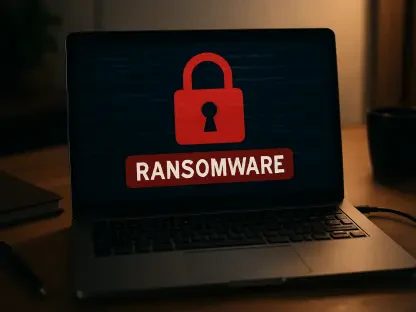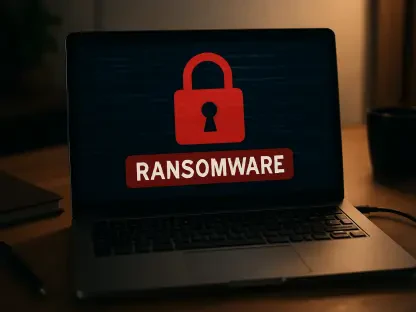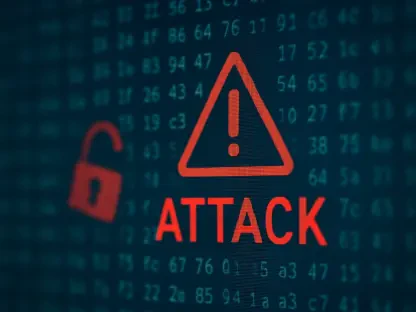The realm of cybersecurity is a constantly shifting landscape, where increasingly sophisticated attacks challenge organizations worldwide. From state-sponsored hacker activities to vulnerabilities in widely used services, the necessity for advanced security measures has never been more critical. This discussion delves into recent developments, various threats, and effective strategies to safeguard systems against these advanced assaults.
Rise of Advanced Cyber Attacks
Russian-Linked Hacker Activities
In recent months, cybersecurity experts have identified a new threat cluster named Storm-2372, believed to be closely aligned with Russian interests. These hackers have been targeting a diverse range of sectors including government, defense, health, energy, telecommunications, and higher education. Their primary method involves a phishing technique known as ‘device code phishing,’ where attackers impersonate prominent individuals to gain users’ trust. Utilizing messaging platforms such as WhatsApp, Signal, and Microsoft Teams, they trick victims into logging into productivity applications, thereby capturing their login credentials and tokens.
Storm-2372’s activities have raised significant alarms across various organizations, indicating a trend toward more nuanced and tailored phishing efforts. The attackers’ adeptness in leveraging familiar platforms ensures a higher likelihood of success, as victims often find these communications to be legitimate. The impersonation strategy effectively lowers the defenses of targeted individuals, making them unwittingly complicit in the breach. This sophisticated approach demands heightened vigilance and robust countermeasures from affected entities to prevent and mitigate security breaches.
Impact on Global Sectors
The repercussions of these cyber-attacks have been felt across multiple global regions, including Europe, North America, Africa, and the Middle East. The targeted sectors, essential to the functioning of societies, are facing substantial risks, as compromised systems can lead to disruption of critical services. Government structures, energy supplies, healthcare services, and educational institutions are particularly vulnerable, necessitating a concerted response to these sophisticated threats.
In response to the attacks, organizations within these impacted sectors must employ multi-layered security strategies to safeguard their operations. Beyond immediate steps, there is a need for ongoing vigilance and adaptation to counteract the ever-evolving tactics of cyber adversaries. Educational initiatives, fortified security protocols, and enhanced detection mechanisms are fundamental in building resilient defense systems. The global nature of these threats also underscores the importance of international cooperation in cybersecurity efforts, aiming to share information, resources, and best practices to collectively fend off future attacks.
Proactive Security Measures
The Need for Automated Pentesting
In addressing the increasing complexities of cyber threats, organizations are recognizing the vital role of automated penetration testing (pentesting). Analogous to sparring in boxing, automated pentesting involves constant practice and exposure to varied attack methods, enabling organizations to systematically identify and address vulnerabilities in their security posture. The continuous nature of this testing helps reveal weak points that may otherwise remain hidden, thereby fortifying the overall resilience of cybersecurity infrastructures.
Automated pentesting tools simulate real-world attacks, allowing security teams to understand how cyber criminals might exploit their systems. This proactive approach not only helps in identifying vulnerabilities but also guides the refinement of defensive strategies. By incorporating automated pentesting into regular security protocols, organizations can ensure that their defenses are robust and adaptive, capable of withstanding both known and emerging threats. The relentless pace of cyber adversaries requires equally relentless security testing to maintain a fortified cybersecurity landscape.
Continuous Improvement in Security
Maintaining a resilient security posture is an ongoing endeavor, necessitating continuous improvement and adaptation. Regularly challenging defenses through automated pentesting is essential for keeping pace with evolving cyber threats. This process involves a cyclical pattern of testing, identifying vulnerabilities, implementing fixes, and reassessing the security measures to ensure they stand up against new attack techniques. By employing a dynamic and iterative approach, organizations can build a robust defense system capable of mitigating risks effectively.
The philosophy behind continuous improvement in cybersecurity aligns with the notion that static defenses are insufficient against dynamic threats. As attackers innovate and develop new methods, organizations must equally innovate in their defensive strategies. This involves not only technical enhancements but also organizational changes, such as fostering a culture of security awareness and responsiveness. Continuous improvement encapsulates the integration of advanced detection tools, rigorous testing protocols, and a commitment to staying ahead of potential threats, providing a comprehensive security strategy equipped to handle the complexities of the modern cybersecurity landscape.
Vulnerabilities in Widely Used Services
OAuth Redirect Flaw in Airline Travel Integration
A critical vulnerability has been disclosed in the OAuth implementation of a widely used online travel service, which exposed millions of user accounts to potential hijacking. The flaw stemmed from insecure handling of redirect URLs, allowing attackers to gain unauthorized access to sensitive information. Exploiting this vulnerability, attackers could impersonate users, alter booking details, and misuse loyalty points, resulting in significant implications for affected individuals.
The discovery of this vulnerability underscores the importance of scrutinizing third-party integrations, especially those involving OAuth, a prevalent authorization framework used across numerous online services. The impacted travel service integrated with commercial airlines, making the scale of the exposure vast. Despite the flaw being patched, the incident highlighted the necessity for stringent validation and security assessment of OAuth implementations to prevent similar breaches in the future. Ensuring robust security in such integrations is critical to maintaining user trust and system integrity.
Prometheus Instances Exposure
An alarming number of Prometheus monitoring and alerting toolkit instances are currently exposed due to inadequate authentication measures. Researchers have identified approximately 296,000 Prometheus Node Exporter instances and 40,300 Prometheus servers that are publicly accessible on the internet, placing them at substantial risk of information leakage, denial-of-service (DoS), and remote code execution (RCE) attacks. The accessibility of these servers makes them highly attractive targets for cyber adversaries, who can exploit the lack of security configurations to compromise data and disrupt services.
Securing Prometheus instances involves implementing stringent authentication protocols and access controls to mitigate the risks associated with their exposure. Given the integral role of monitoring and alerting tools in managing system performance and detecting anomalies, ensuring their protection from cyber threats is paramount. Organizations leveraging Prometheus must prioritize security measures, including securing endpoint configurations, routinely updating software, and conducting regular security audits. By fortifying the security of monitoring tools, they can prevent unauthorized access and safeguard critical operational data.
Authentication Challenges
Transitioning to Passwordless Authentication
Passwordless authentication has been gaining traction as a promising solution to mitigate risks associated with compromised passwords. However, the transition to such systems entails navigating several practical challenges. Key concerns include ensuring the robustness of alternative authentication methods, such as biometrics or security tokens, and balancing them with user convenience and experience. The adoption of passwordless systems requires meticulous planning to ensure seamless integration without compromising security.
Implementing passwordless authentication involves addressing compatibility issues with existing infrastructures and managing the diverse needs of users. Organizations must establish strong security frameworks for alternative methods to prevent identity theft or unauthorized access. Additionally, user education and support are crucial in facilitating the shift from traditional passwords to more advanced authentication techniques. The complexity of this transition underscores the importance of a phased approach, piloting passwordless methods in controlled environments, and scaling based on successful outcomes.
Strengthening Existing Protocols
While the concept of moving towards passwordless authentication is appealing, many organizations find that strengthening existing password protocols offers a more immediate and manageable solution. Improving password policies, enforcing complex password requirements, and deploying multi-factor authentication (MFA) can significantly enhance security without the need for a complete overhaul. Focusing on these measures can mitigate the risks posed by weak or compromised passwords, which remain a major vector for data breaches.
Organizations can leverage tools and technologies to bolster their existing password systems, including password managers, secure storage solutions, and regular audits to detect vulnerabilities. Enhancing the security of password protocols requires continuous education and training for users to promote best practices and awareness of potential threats. By refining current methods, organizations can effectively reduce the attack surface and manage user credentials more securely, providing a practical and immediate defense against cyber threats.
Security Gaps in Biometric Systems
Vulnerabilities in ZKTeco Biometric System
A comprehensive analysis of the ZKTeco hybrid biometric access system has unveiled 24 critical security flaws, including SQL injections, buffer overflows, command injections, and arbitrary file operations. These vulnerabilities allow attackers to bypass authentication mechanisms, steal biometric data, manipulate devices, and deploy backdoors. The discovery of such extensive flaws in a biometric system, increasingly relied upon for secure access control, highlights the critical necessity for rigorous security testing and timely patching.
Securing biometric systems requires a multi-faceted approach encompassing thorough vulnerability assessments, prompt remediation, and continuous monitoring. The inherent sensitivity of biometric data mandates the highest standards of security, as breaches can have far-reaching consequences, including identity theft and unauthorized access. Organizations employing biometric systems must prioritize the implementation of robust encryption methods, secure device configurations, and regular security updates. These measures are essential in safeguarding the integrity and confidentiality of biometric data against sophisticated cyber threats.
Importance of Thorough Security Testing
The vulnerabilities discovered in ZKTeco’s biometric system emphasize the importance of exhaustive security testing and timely patching. Biometric systems, due to their nature of storing and processing sensitive information, require comprehensive security protocols to prevent unauthorized access. Regular testing and validation can uncover potential flaws before they are exploited by malicious actors. Ensuring the security of biometric systems involves not only addressing known vulnerabilities but also anticipating and mitigating emerging threats.
Thorough security testing must be integrated into the development and deployment stages of biometric systems. This entails comprehensive code reviews, penetration testing, and adherence to security standards and best practices. Establishing a proactive security strategy that encompasses regular audits and continuous monitoring helps organizations maintain the integrity of biometric systems and safeguard sensitive information. The importance of rigorous testing cannot be overstated in the context of biometric security, where the potential for exploitation demands vigilant and ongoing scrutiny.
Interconnected Ecosystem Risks
1Password Security Breach Incident
A notable incident involving a breach in Okta’s support system had direct implications for 1Password, highlighting the interconnected risks within digital ecosystems. Threat actors accessed a session cookie through a shared HTTP Archive (HAR) file, attempting to leverage it to gain access to administrative user data. Although 1Password reported that no user data was compromised and the malicious activity was swiftly terminated, the incident serves as a stark reminder of the potential vulnerabilities inherent in interconnected systems.
This breach underscores the necessity for robust and comprehensive incident response mechanisms. Efficient detection, swift response, and thorough analysis are crucial components in mitigating the risks posed by such breaches. Collaborative security strategies among interconnected service providers can enhance overall resilience, ensuring that threats are swiftly identified and neutralized. Lessons learned from such incidents can drive improvements in protocols and defenses, fostering a more secure and vigilant digital ecosystem.
Lessons from Incident Response
The world of cybersecurity is ever-evolving, marked by increasingly sophisticated attacks that pose significant challenges to organizations across the globe. Cyber threats come from various sources, including state-sponsored hackers and vulnerabilities within commonly used services, highlighting the urgent need for advanced security measures. Keeping up with the latest developments, understanding the array of emerging threats, and implementing effective defensive strategies have never been more critical.
This discussion explores the most recent trends and threats in cybersecurity, emphasizing the importance of a robust approach to protect systems from these heightened risks. Whether it’s the latest ransomware campaigns, zero-day exploits, or phishing schemes, the threats are varied and relentless. Organizations must adopt a proactive stance, employing multi-layered defensive mechanisms, and staying informed about the latest security protocols to effectively safeguard their digital assets from these advanced and evolving assaults.









